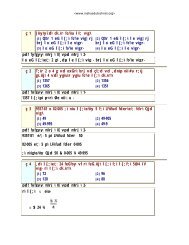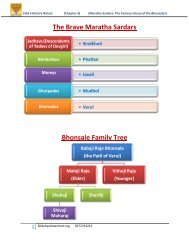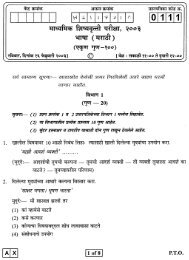Page | 1 ©MahaEduTechNet Team Chemical reactions and ...
Page | 1 ©MahaEduTechNet Team Chemical reactions and ...
Page | 1 ©MahaEduTechNet Team Chemical reactions and ...
Create successful ePaper yourself
Turn your PDF publications into a flip-book with our unique Google optimized e-Paper software.
<strong>Page</strong> | 1<br />
<strong>Chemical</strong> <strong>reactions</strong> <strong>and</strong> equations<br />
• Following observations helps us to determine whether a chemical reaction has taken place :<br />
o change in state<br />
o change in color<br />
o evolution of a gas<br />
o change in temperature<br />
• Balanced chemical equation<br />
o Law of conservation of mass states that mass can neither be created nor be destroyed in a chemical<br />
reaction. In other words, the number of atoms of each element remains the same before <strong>and</strong> after a<br />
chemical reaction. That’s why we need to balance a chemical equation.<br />
o Steps involved in balancing a chemical equation : Consider a chemical reaction taking place when iron<br />
comes in contact with steam :<br />
Fe + H 2 O Fe 3 O 4 + H 2 (Fe 3 O 4 is FeO.Fe 2 O 3 )<br />
• Step 1 : Draw boxes around each formula. Do not change anything inside the boxes while balancing<br />
the equation.<br />
Fe + H 2 O Fe 3 O 4 + H 2<br />
• Step 2 : List the number of atoms of different elements present in the unbalanced equation :<br />
Element Number of atoms in reactants (LHS) Number of atoms in products (RHS)<br />
Fe 1 3<br />
H 2 2<br />
O 1 4<br />
• Step 3 : It is often convenient to start balancing with the compound that contains maximum number<br />
of atoms. It may be a reactant or a product. In that compound select the element which has the<br />
maximum number of atoms. In the above equation, Fe 3 O 4 is the compound with maximum atoms<br />
<strong>and</strong> O is the element that has maximum atoms. So let's try to balance O on both sides. On LHS there<br />
is only 1 O atom <strong>and</strong> on RHS there are 4 O atoms. Hence our partly balanced equation is :<br />
Fe +4 H 2 O Fe 3 O 4 + H 2 ……………………… (Partly balanced equation)<br />
(We have written 4 H 2 o <strong>and</strong> not H 2 O 4 )<br />
Rewrite the number of atoms of different elements present in the partly balanced equation :<br />
Element Number of atoms in reactants (LHS) Number of atoms in products (RHS)<br />
Fe 1 3<br />
H 8 2<br />
O 4 4<br />
• Step 4 : Now let us balance F atoms on both sides. F on LHS = 1, F on RHS = 3. Let's balance them :<br />
3 Fe +4 H 2 O Fe 3 O 4 + H 2 ……………………… (Partly balanced equation)<br />
Rewrite the number of atoms of different elements present in the partly balanced equation :<br />
Element Number of atoms in reactants (LHS) Number of atoms in products (RHS)<br />
Fe 3 3<br />
H 8 2<br />
O 4 4<br />
©MahaEduTechNet <strong>Team</strong>
<strong>Page</strong> | 2<br />
• Step 5 : Finally let's balance H atoms. H on LHS = , H on RHS = 2. Let's balance them :<br />
3 Fe +4 H 2 O Fe 3 O 4 +4 H 2 …………… …………… (balanced equation)<br />
Rewrite the number of atoms of different elements present in<br />
the balanced equation :<br />
o<br />
Element<br />
Number of atoms in reactants (LHS) Number of atoms in products (RHS)<br />
Fe<br />
3<br />
3<br />
H<br />
8<br />
8<br />
O<br />
4<br />
4<br />
• Step 6 : Write symbols of physical states : gaseous ‐ (g), liquid ‐ (l), solid ‐ (s), aqueous (aq). (aq) is<br />
written when a reactant or a product in present as a solution in water.<br />
3 Fe (s) + 4 H 2 O (g) Fe 3 O 4 (s) + 4 H 2 (g)<br />
(g) is used for H 2 O to indicate water is in the form<br />
of steam.<br />
Entities like presence of catalysts, pressure, temperaturee are written above or below the arrow in the<br />
equation like :<br />
CO (g) + 2H 2 CH 3 OH (l) ( ………………… Pressure 340 atm is indicated)<br />
• Types of chemical <strong>reactions</strong> : During a chemical reaction, atoms of one element do not change into those of another<br />
element. Nor do the atoms<br />
disappear from the mixture or appear from elsewhere. Actually<br />
the chemical <strong>reactions</strong><br />
involve making <strong>and</strong> breaking of bonds between atoms to produce<br />
new substances.<br />
o Combination reaction : When two or more substances (elements or compounds) combine to form a single<br />
product, the <strong>reactions</strong> are called combination <strong>reactions</strong>.<br />
• Examples :<br />
•<br />
A solution of slaked lime produced by the<br />
reaction above is used for white washing walls.<br />
Calcium hydroxide reacts slowly with the<br />
carbon dioxide in air to form a thin layer of calcium<br />
carbonate on the walls. Calcium carbonate is formed after 2‐3 days of white washing <strong>and</strong><br />
gives a shiny finish to the walls. It is interesting to know that chemical formula for marble<br />
(<strong>and</strong> chalk too) is CaCO 3 .<br />
• Burning of coal :<br />
• Formation of water from hydrogen <strong>and</strong> oxygen.<br />
• Exothermic <strong>reactions</strong> : Reactions in which heat is<br />
released along with the formation of products are<br />
called exothermic <strong>reactions</strong>.<br />
• Examples :<br />
o<br />
o<br />
Burning<br />
of natural gas.<br />
We need energy to stay alive. We<br />
get this energy from the<br />
food we eat. During<br />
digestion, food is broken down into simpler substances (e. g. carbohydrates into<br />
©MahaEduTechNet <strong>Team</strong>
<strong>Page</strong> | 3<br />
glucoses). This glucose combines<br />
with the oxygen in the cells <strong>and</strong> provides energy.<br />
This reaction is called respiration<br />
<strong>and</strong> is an exothermic reaction.<br />
o<br />
o The decomposition<br />
of vegetable matter is also<br />
an exothermic reaction.<br />
o Reaction of slaked lime with water is also an example of exothermic reaction.<br />
Decomposition reaction : A chemical reaction in which a single reactant breaks down to gove simpler<br />
products is called a decomposition reaction.<br />
• Examples :<br />
• Decomposition<br />
by heating<br />
o When ferrous sulphate crystals ( FeSO 4 .7H2O) are heated FeSO 4 decomposes to give<br />
ferric oxide (solid) <strong>and</strong> sulphur dioxide <strong>and</strong> sulphur trioxide (gases).<br />
o<br />
When calcium carbonate (limestone) is heated it decomposes to calcium oxide<br />
(quicklime) <strong>and</strong> carbon dioxide (g). This reaction is used in various industries.<br />
o<br />
Another example of<br />
decomposition by heat is<br />
:<br />
• Decomposition<br />
by sunlight<br />
o Silver chloride turns<br />
grey in sunlight.<br />
o<br />
Silver bromide also behaves in the same way.<br />
The above <strong>reactions</strong><br />
are used in black <strong>and</strong> white photography.<br />
• Decomposition<br />
by electricity<br />
o When electric current is passed through water hydrogen <strong>and</strong> oxygen gases are<br />
released at electrodes.<br />
o<br />
H 2 O (l)<br />
H 2 (g) + O 2 (g)<br />
• All decomposition <strong>reactions</strong> require energy in some form (heat, light, electricity). Reactions in whichh<br />
energy is absorbed are known as endothermic <strong>reactions</strong>.<br />
Displacement <strong>reactions</strong> : In a displacement reaction, an element or ion moves out<br />
of one compound <strong>and</strong><br />
into another. (One<br />
element is replaced by another in a compound.)<br />
• Examples :<br />
©MahaEduTechNet <strong>Team</strong>
<strong>Page</strong> | 4<br />
• When iron nail is dipped in aqueous copper sulphate solution, Copper is displaced by iron.<br />
• Other examples of displacement <strong>reactions</strong> are :<br />
o<br />
• Zinc <strong>and</strong> lead are more reactive elements<br />
than copper. They displace copper from its<br />
compounds.<br />
Double displacement <strong>reactions</strong><br />
: <strong>Chemical</strong> <strong>reactions</strong> in which there is an exchangee of ions between the<br />
reactants are called double displacement <strong>reactions</strong>.<br />
o<br />
•<br />
Oxidation <strong>and</strong> reduction <strong>reactions</strong> : If a substance gains oxygen during a reaction, it is said to be oxidized. If<br />
a substance loosess oxygen during a reaction, it is said to be reduced.<br />
• Oxidation <strong>reactions</strong> :<br />
•<br />
•<br />
•<br />
• Redox <strong>reactions</strong> : A chemical reaction in which one reactant gets oxidized <strong>and</strong> another reactant gets<br />
reduced is<br />
called a redox reaction.<br />
•<br />
•<br />
(Copper is reduced <strong>and</strong> hydrogen<br />
is oxidized)<br />
(Zinc is reduced <strong>and</strong> carbon<br />
is oxidized)<br />
•<br />
• Effects of oxidation in daily life :<br />
(Manganese is reduced, hydrogen is oxidized)<br />
• When new, iron<br />
articles are shiny but over time, they are coated with reddish brown<br />
powder. This is due to rusting of iron (formation of Fe<br />
3 O 4 (i.e. FeO. .Fe 2 O 3 )).<br />
• Some other metals like silver <strong>and</strong> copper<br />
are also attacked by the substances around (like<br />
moisture, acids<br />
etc.). Due to<br />
such attack chemical reaction takes place <strong>and</strong> a coating of<br />
metal compounds appears on metal surfaces (black in<br />
case of silver, green in case of<br />
copper). This coating tarnishes the metal<br />
surface (surface looses shine). This process is<br />
called corrosion. Corrosion causes damage to car bodies, bridges, iron railings, ships etc.<br />
• When fats <strong>and</strong> oils present in food items come in contact with oygen for a long time, they<br />
are oxidized. Food becomes<br />
rancid <strong>and</strong> smell <strong>and</strong> taste change in an undisirable<br />
manner. So<br />
antioxidants (substances which avoid oxidation) are used, or, food stuff is packed in air tightt<br />
containers. Potato chip manufacturers fills nitrogen gas in chip packings to avoid oxidation.<br />
©MahaEduTechNet <strong>Team</strong>




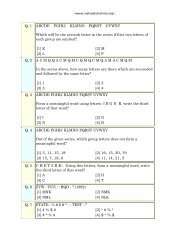
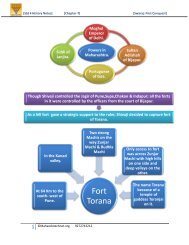
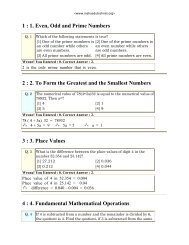

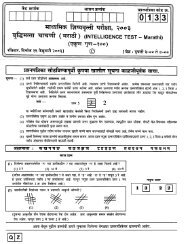
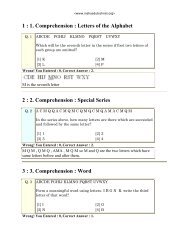
![1 % 1 vkdyu ç 1 la[;kekyk % 10]](https://img.yumpu.com/29696418/1/190x245/1-1-vkdyu-a-1-lakekyk-10.jpg?quality=85)
